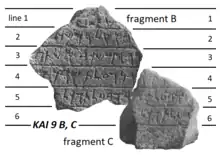
The Son of Safatba'al inscription is a Phoenician inscription (KAI 9) dated to c. 500-475 BCE.
It was published in Maurice Dunand's Fouilles de Byblos (volume I, 1926–1932, numbers 1143, plate XXXIII).[1]
It is currently at the National Museum of Beirut.
Text of the inscription
Three parts of the inscription are extant. The largest, fragment A (six lines), reads:[2][3]
P‘LT
LY
HMŠKB
ZN
[...
I made for myself this resting-place (tomb) [...
...]BYTK
BL
T[QM
LŠT]
’RN
‘LT
’RN
...] your tomb (?). You shall not per[sist in placing] coffin upon coffin.
‘L
KN
P‘L[T
LY
HMŠKB
ZN
...
For this reason have I mad[e for myself this resting-place ...
...
WP‘L
’NK
’RN
ZN
L]Y
BMŠKB
ZN
’Š
’NK
ŠKB
BN
... and I made this coffin for mys]elf in this resting-place that I (am) lying in.
WBMQM
[ZN
...
And in [this] place [...
...]LY
’N[K
..]TY
BRBM
WYTN
’NK
’[...
...] for myself I [...] among the generals. And I gave [...
...
’L
TPT]Ḥ
‘[LT
HMŠKB]
ZN
LRGZ
‘ṢMY
’[M...
... you shall not ope]n this [resting-place] to disturb my bones. [...
...(?)ŠM]Š
‘L[M...
... Ete]rnal Se[mes (Sun-goddess) (?) ...

Two smaller fragments, B and C, have been joined together and are now known as fragment B. It reads:
...]H[...
...
...
’L
TP‘L
LK
MŠK]B
’ṢL
HMŠK[B
ZN
...
... You shall not make for yourself a resting-pla]ce (tomb) adjacent to [this] resting-pla[ce! ...
...]QR
HMŠKB
’Š
TP[TḤ...
...]QR(?) the resting-place that you op[en ...
...
’L
YŠT
’Y]T
’RNW
‘LT
’RN
’N[K...
... Let him not place] his coffin upon a coffin. I[...
...
B‘LŠM]M
WB‘L
’DR
WB‘LT
WKL
’[LN
GBL
...
... Baalsame]m and Baal ’Iddīr[5] and Baalat and all the god[s of Byblos ...
...]B‘LT
WKL
[’L
...
...] Baalat and all the [gods ...
Bibliography
- Christopher Rollston, "The Dating of the Early Royal Byblian Phoenician Inscriptions: A Response to Benjamin Sass." MAARAV 15 (2008): 57–93.
- Benjamin Mazar, The Phoenician Inscriptions from Byblos and the Evolution of the Phoenician-Hebrew Alphabet, in The Early Biblical Period: Historical Studies (S. Ahituv and B. A. Levine, eds., Jerusalem: IES, 1986 [original publication: 1946]): 231–247.
- William F. Albright, The Phoenician Inscriptions of the Tenth Century B.C. from Byblus, JAOS 67 (1947): 153–154.
References
- ↑ Dunand, Maurice (1939). Fouilles de Byblos: Tome 1er, 1926-1932 [The Byblos excavations, Tome 1, 1926–1932]. Bibliothèque archéologique et historique (in French). Vol. 24. Paris: Librarie Orientaliste Paul Geuthner. and Dunand, Maurice (1937). Fouilles de Byblos, Tome 1er, 1926–1932 (Atlas) [The Byblos excavations, Tome 1, 1926–1932 (Atlas)]. Bibliothèque archéologique et historique (in French). Vol. 24. Paris: Librarie Orientaliste Paul Geuthner – via https://gallica.bnf.fr.
{{cite book}}: External link in|via= - ↑ Donner, Herbert; Rölig, Wolfgang (2002). Kanaanäische und aramäische Inschriften (5 ed.). Wiesbaden: Harrassowitz. p. I, 2.
- ↑ Krahmalkov, Charles R. (2000). Phoenician-Punic Dictionary. Leuven: Peeters / Departement Oosterse Studies. ISBN 90-429-0770-3.
- ↑ Possibly Urimilk II.
- ↑ Ba‘al ’Iddīr or ’Addīr: Powerful, Great, or Mighty Baal.